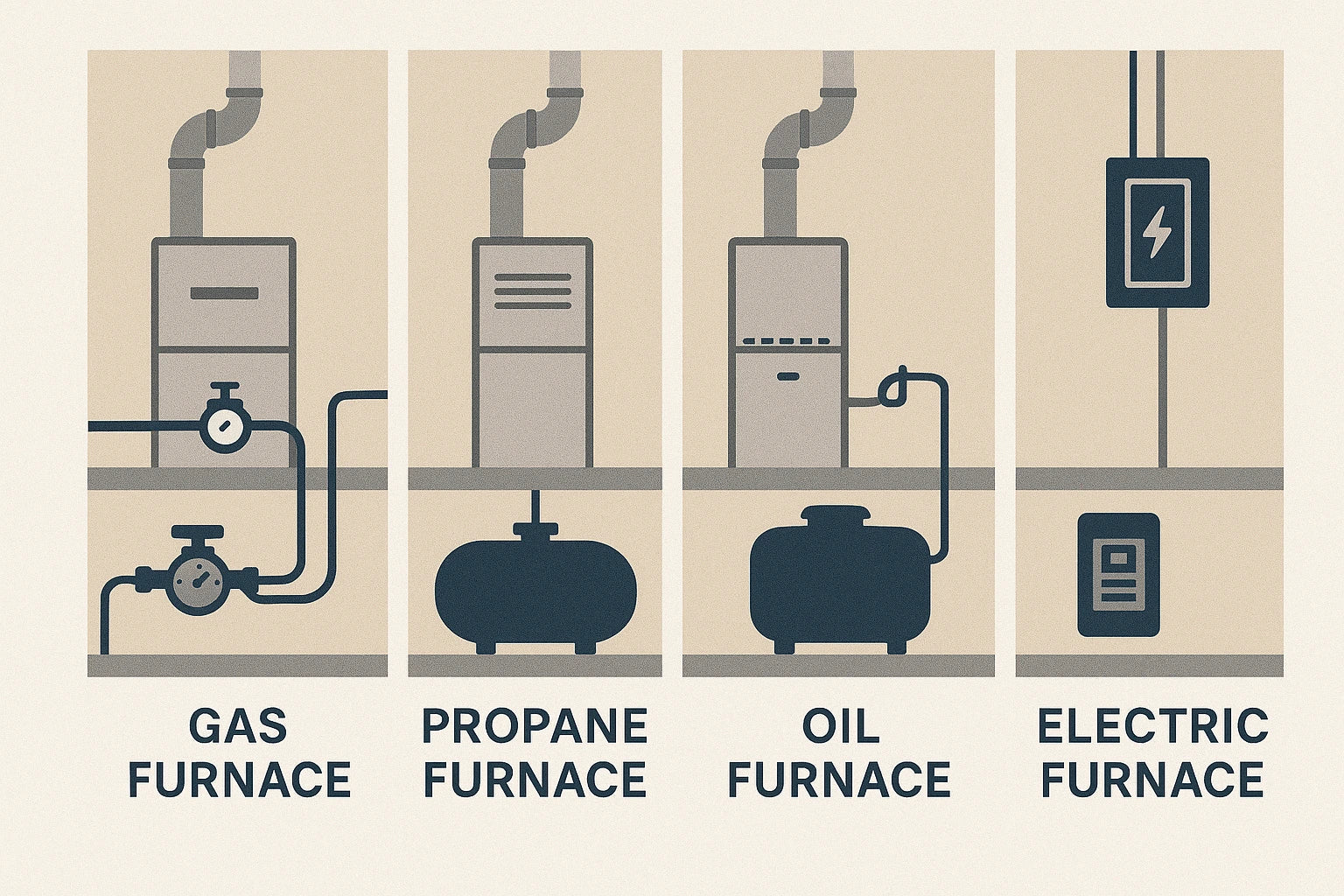Not all furnaces are created equal — and the type of fuel your system uses has a huge impact on installation cost, operating expenses, and long-term savings.
If you’re replacing a furnace in 2025, you might be deciding whether to stick with your current fuel type or switch to something more efficient or affordable. That choice can add (or shave) thousands off your lifetime heating costs.
In this guide, we’ll break down the cost differences for propane, oil, natural gas, and electric furnaces, including upfront installation prices, annual operating costs, maintenance needs, and environmental impact — so you can make a confident, budget-smart decision.
📘 If you’re still researching general furnace prices, start with How Much Does a New Furnace Cost? for a full breakdown of what impacts cost beyond fuel type.
Upfront Installation Costs by Fuel Type
Installation costs can vary widely depending on the fuel source, efficiency rating, and home setup. Here’s what you can expect in 2025:
| Fuel Type | Typical Installed Cost Range |
|---|---|
| Natural Gas | $4,500–$9,500 |
| Propane | $5,000–$9,500 |
| Oil | $6,000–$10,500 |
| Electric | $4,000–$8,000 |
These ranges include the furnace unit, labor, and basic installation but don’t account for major upgrades like duct replacement or fuel line installation.
For more on choosing the right system, the ENERGY STAR Furnace Buying Guide covers efficiency ratings, sizing, and features to consider.
Operating Costs by Fuel Type
Your monthly heating bills are heavily influenced by fuel prices and furnace efficiency.
Natural Gas Furnaces
-
Pros: Lowest operating cost in areas with access to gas lines. Reliable, stable supply in most urban and suburban areas.
-
Cons: Requires existing gas service or costly connection fees.
-
Average annual operating cost: $600–$1,200 for a typical 2,000 sq. ft. home.
-
Fuel price resource: U.S. Energy Information Administration – Natural Gas Prices tracks regional and seasonal fluctuations.
Propane Furnaces
-
Pros: Cleaner burning than oil, widely available in rural areas without natural gas.
-
Cons: Higher fuel cost than natural gas, requires on-site tank storage.
-
Average annual operating cost: $1,200–$2,400.
-
Learn more at the Propane Education & Research Council, which outlines performance and efficiency benefits.
Oil Furnaces
-
Pros: Powerful heat output, common in older homes and colder climates.
-
Cons: Higher and more volatile fuel prices, larger environmental footprint. Requires frequent maintenance to remove soot buildup.
-
Average annual operating cost: $1,800–$3,000.
-
For technical details, see the DOE – Oil-Fired Heating Systems page.
Electric Furnaces
-
Pros: Lowest upfront cost, easy installation, no fuel storage. 100% efficient at converting electricity to heat at point of use.
-
Cons: Highest operating cost in most climates unless paired with solar or low-cost electricity. Performs best in mild climates.
-
Average annual operating cost: $1,500–$3,500.
-
Details are available at DOE – Electric Resistance Heating.
Maintenance & Lifespan Considerations
Fuel type also affects how often you’ll need service and how long your furnace will last.
-
Oil furnaces require annual tune-ups and more frequent filter changes due to soot. Lifespan: 15–20 years.
-
Natural gas and propane furnaces should be inspected yearly for leaks and combustion efficiency. Lifespan: 15–20 years.
-
Electric furnaces need minimal maintenance but may have a shorter lifespan (10–15 years) in colder climates with heavy use.
Environmental Impact & Efficiency
-
Natural Gas & Propane: Produce fewer emissions than oil but are still fossil fuels. High-efficiency models can reach 98% AFUE.
-
Oil: Higher carbon emissions, but ultra-low sulfur heating oil can reduce environmental impact.
-
Electric: Carbon footprint depends on the local power grid — can be very low if powered by renewable energy.
The Carrier Furnace Buying Guide explains how AFUE ratings work and how they can help you compare efficiency across different fuel types before making a purchase.
Choosing the Right Fuel Type for Your Home
When deciding, consider:
-
Fuel availability – Is your area served by natural gas? If not, propane or oil may be your options.
-
Local fuel prices – High propane or oil costs could make electric more appealing if paired with renewables.
-
Climate – Electric furnaces work well in mild climates; gas or oil are better for extreme cold.
-
Upfront budget vs. lifetime cost – The cheapest install isn’t always the cheapest long-term.
-
Future plans – If you plan to stay for 10+ years, efficiency savings matter more.
When Switching Fuel Types Makes Sense
-
You’re adding a new fuel source anyway — e.g., installing a natural gas line for a range or water heater.
-
You want lower operating costs — switching from oil to gas can save thousands over a decade.
-
You’re going electric for environmental goals — especially if pairing with solar panels or buying renewable power.
Final Thoughts – Match Fuel Type to Your Budget & Climate
Fuel choice is one of the most important decisions in a furnace replacement. It impacts your upfront investment, monthly bills, maintenance needs, and even the comfort of your home.
If you’re replacing your furnace in 2025, weigh both installation costs and lifetime operating expenses before committing. The cheapest unit today may not be the cheapest to run over the next 15–20 years.
📘 Next read: How Much Should a Furnace Tune-Up or Minor Repair Cost in 2025? to learn how annual maintenance costs compare across different fuel types.
Alex Lane
Your Home Comfort Advocate







